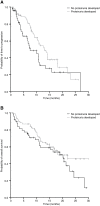Correlation of hypertension and proteinuria with outcome in elderly bevacizumab-treated patients with metastatic colorectal cancer
- PMID: 25602286
- PMCID: PMC4300229
- DOI: 10.1371/journal.pone.0116527
Correlation of hypertension and proteinuria with outcome in elderly bevacizumab-treated patients with metastatic colorectal cancer
Abstract
Background: Studies suggest a relationship between hypertension and outcome in bevacizumab-treated patients with metastatic colorectal cancer (mCRC). We performed a retrospective analysis of two phase II studies (BECA and BECOX) to determine if hypertension and proteinuria predict outcome in elderly patients with mCRC treated with bevacizumab.
Patients and methods: Patients ≥ 70 years of age received either capecitabine 1250 mg/m(2) bid days 1-14 + bevacizumab 7.5 mg/kg day 1 every 21 days (BECA study) or capecitabine 1000 mg/m(2) bid days 1-14 with bevacizumab 7.5 mg/kg and oxaliplatin 130 mg/m(2) day 1 (BECOX study). The primary objective was to correlate hypertension and proteinuria with overall response rate (ORR), time to progression (TTP) and overall survival (OS). Secondary objectives included identification of risk factors associated with the development of hypertension and proteinuria and determining whether development of hypertension or proteinuria in the first 2 cycles was related to ORR, disease-control rate (DCR), TTP or OS.
Results: In total, 127 patients (median age 75.5 years) were included in the study. Hypertension correlated with DCR and OS; proteinuria correlated with ORR and DCR. Proteinuria or hypertension in the first 2 cycles did not correlate with efficacy. Risk factors for hypertension were female gender (odds ratio [OR] 0.241; P = 0.011) and more bevacizumab cycles (OR 1.112; P = 0.002); risk factors for proteinuria were diabetes (OR 3.869; P = 0.006) and more bevacizumab cycles (OR 1.181; P<0.0001). Multivariate analysis identified as having prognostic value: baseline lactate dehydrogenase, haemoglobin, number of metastatic lesions and DCR.
Conclusion: This analysis of two phase II studies suggests that hypertension is significantly correlated with OS but not with ORR and TTP, whereas proteinuria is correlated with ORR but not with OS and TTP. Both hypertension and proteinuria are associated with the duration of bevacizumab treatment and do not represent an independent prognostic factor.
Conflict of interest statement
Figures


References
-
- Cancer Research UK. Bowel cancer incidence statistics. Available: http://www.cancerresearchuk.org/prod_consump/groups/cr_common/@cah/@gen/.... Accessed 2014 Jul 10.
Publication types
MeSH terms
Substances
LinkOut - more resources
Full Text Sources
Other Literature Sources
Medical

